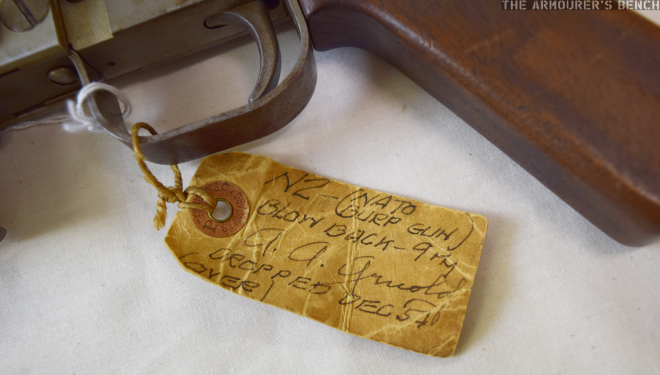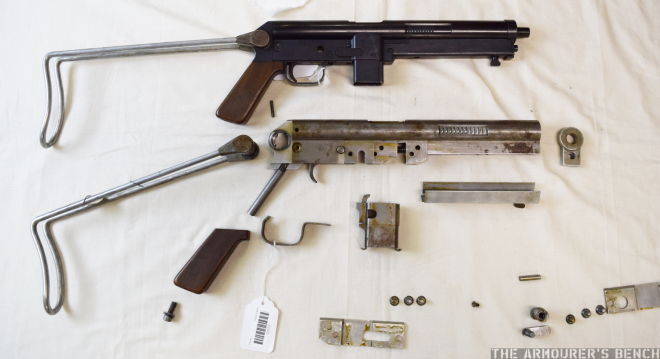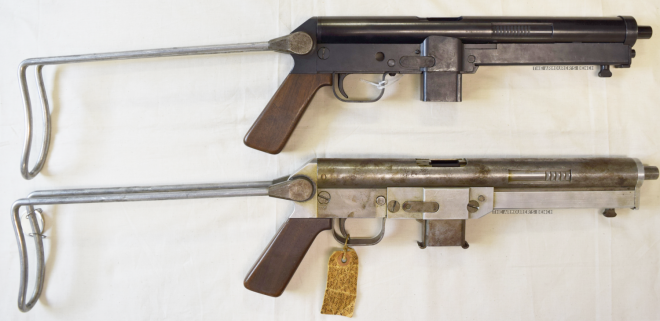When we think of the Winchester Repeating Arms Company we think of lever actions and maybe some of John Browning’s designs. We don’t tend to think of Cold War submachine guns, but in the mid-1950s Winchester developed a 9×19 ‘NATO Burp Gun’. During a research trip to the Cody Firearms Centre at the Buffalo Bill Center of the West earlier this year, I was able to examine, disassemble and film the Winchester SMG for my video project, the Armourer’s Bench.
The Cody Firearms Museum in Wyoming holds two examples of Winchester SMG but there is very little documentary evidence available on the guns. I’ve been unable to find any patents, documents or records discussing the guns, the primary source of information on Winchester’s SMG program comes from a single inventory tag on one of the prototypes.

Close up of the N2’s original inventory tag which explains much of the Winchester SMGs’ history (Photo: Matthew Moss, courtesy of the Cody Firearms Museum)
In under 100 words, the tag tells us that it was designed by A.A Arnold, one of Winchester’s engineers, that it was called the ‘N2’, that it had a 33 round magazine, a folding stock and was chambered in 9x19mm. It refers to the gun as a ‘NATO Burp Gun’ but I contacted NATO’s archives while researching and they could find no record of involvement in the gun’s development. It’s more likely that the gun was developed for sale to NATO nations.
In the video below I examine both prototypes and see how the guns worked, how the design evolved and look at the context in which Winchester built them:
The Cody Firearms Museum has two prototypes, an earlier ‘in the white’ prototype which is tagged as the N2 as well as a second gun, and a later slightly more developed blued prototype which is described as the N4 by the museum’s former curator. Both use the same layout and action but differ in a number of ways.
The N2’s tag also gives us an idea of why the project was abandoned. The earlier prototype suffered problems feeding and its recoil spring was so strong it was difficult to cock. The prototypes are simple blowback submachine guns but they have an interesting swept back pistol grip, a wire folding stock which folds to act as a front grip and an unusual grip cocking method similar to the World War Two BSA WELGUN’s.
With so little documentary evidence available the only way to learn about the Winchester ‘NATO’ SMGs was to disassemble one. The N2 was fairly simple to disassemble with aluminium side plates, recoil spring cover and muzzle cap, held together by screws and pins. The gun’s receiver is made up of a piece of shaped sheet metal with a rounded upper half containing the barrel, bolt, and cutouts for the grip points on the bolt assembly (for cocking). The bolt assembly rides over the rear portion of the barrel and projects back into the receiver. The lower section of the stamped receiver is rectangular and has a cut out for a separate magazine housing and fire control mechanism consisting of a trigger and push through safety. The wide folding stock uses a system similar to the MP40’s.

The N4 above an (almost) fully disassembled N2 (Photo: Matthew Moss, courtesy of the Cody Firearms Museum)
While the exact reason Winchester abandoned the project is unknown it’s likely the gun’s reported reliability issues and the fact that the submachine gun market in the late 1950s was already saturated with both World War Two surplus and new submachine guns like the Carl Gustav m/45, the Madsen M50, the British Sterling submachine gun, and the new Israeli Uzi meant that the ‘NATO market’ for a new submachine gun was minimal. Shame Winchester couldn’t enter the US Army’s new Sub Compact Weapon program. You can find my blog (with more photos) explaining the Winchester SMG’s story in more detail here.
 Your Privacy Choices
Your Privacy Choices
